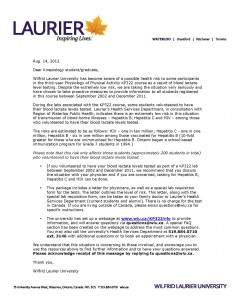Laurier kin students at risk of transmitting Hepatitis B, Hepatitis C and HIV


Kinesiology students who took KP322 (Physiology of Physical Activity) at Wilfrid Laurier University between 2002 and 2011 may be at risk of transmitting Hepatitis B, Hepatitis C and HIV, the university announced Tuesday afternoon.
According to the university, about 200 of the 1,189 students who took the course at WLU in those nine years are at risk because they volunteered for blood lactate testing. A Laurier press release sent out Tuesday said that, “There is an extremely low risk that the way in which the blood sampler device was used in the testing could have resulted in blood transmission among those course participants who volunteered to have their blood lactate levels tested.”
The potential contamination occurred because a blood sampling device that was not meant to be used by multiple individuals was re-used during the testing. A new needle was used after each test and the blood sampler was cleaned with alcohol, however the university has learned that transmission was still possible.
“We’re taking this very seriously,” said Deborah MacLatchy, Laurier provost and vice president: academic. “We understand that students will be concerned, but we’re encouraging them to take the information and talk to their own family physicians.”
MacLatchy said that the university was alerted to the issue when Peter Tiidus, a professor in the kinesiology department, saw a media report on a similar incident at the University of Prince Edward Island. The situation at UPEI is the only other scenario WLU officials are aware of at this time.
According to the university, the risk of transmission among these individuals is very low. With odds of six in 1,000,000 for Hepatitis B, one in 1,000,000 for Hepatitis C and one in 10,000,000 for HIV.
Blood lactate level testing is a regular part of KP322, meant to give students an understanding of lactate — or lactic acid — levels after different activities, for example, the levels following exercise versus the levels following rest.
“The students were providing the sample, but the lab instructor was taking the blood and cleaning the equipment between each use” said MacLatchy.
MacLatchy added that all the lab instructors were Laurier faculty members and that the university has yet to pursue any potential disciplinary measures for those conducting the tests.
“At this point, we’re just very focused on getting the information out to the students and understanding what happened and reviewing our internal processes,” she said.
The last time the blood sampler in question was used in KP322 was the fall semester of 2011 as the course was not offered during the winter of 2012. MacLatchy said that the university is still in the process of reviewing whether they will use an alternative testing method in the future or discontinue the tests altogether.
As of Aug. 14, 133 students were registered for the course in the fall of 2012. Tiidus, who brought the issue to the university’s attention, is the assigned instructor for the coming term.
According to MacLatchy, the university is in the process of alerting all 1,189 students who took the class between 2002 and 2011 via e-mail and physical mail. She added that because the information was just released Tuesday afternoon, at this point, no former or current students have come forward with a positive test for any of the viruses.
“Our first concern is with the student and if they do test positive, [the process will be] to understand whether or not it was from the lab or if it could’ve been from other sources as well,” said MacLatchy.
While all three viruses can be transmitted sexually, MacLatchy said the risk of any transmission among the general student population, beyond the 200 who had their blood tested, is “very, very low.”
Students that may be at risk have been encouraged to get in contact with the university.

The Cord will continue to follow this story. Check back with us online throughout August and look for coverage in our Sept. 2 issue.
** Editor’s note: This article has been updated from its original version. Initially, the year in the 13th paragraph was mistakenly listed as “2007”. It has been corrected to read “2002”.



